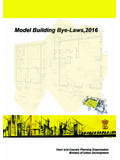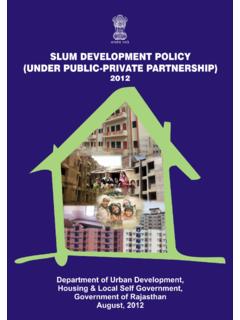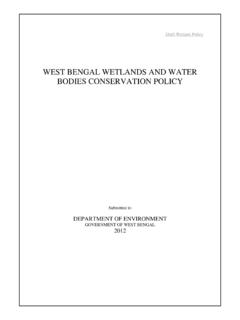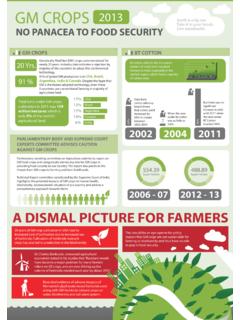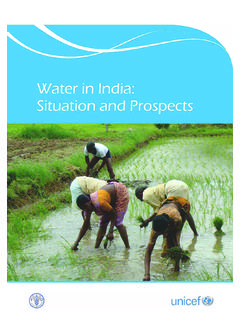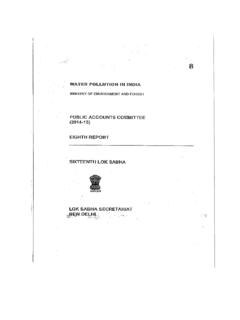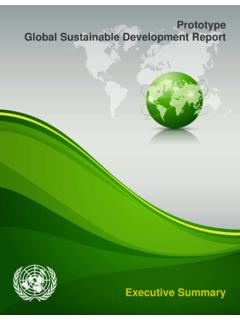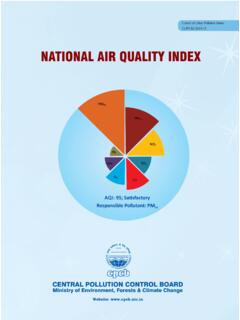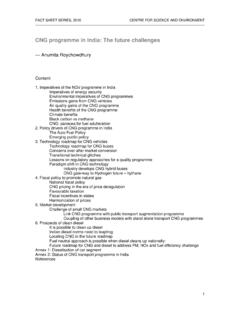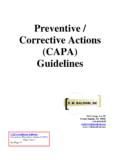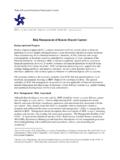Transcription of Implementation Guidelines for E-Waste (Management) …
1 DRAFT. Implementation Guidelines for E-Waste ( management ) Rules, 2016. Central Pollution Control Board, Delhi DRAFT. Abbreviations BFR - Brominated Flame Retardants CCC - Common Collection Centres CFC - Chloro Fluro Carbon CPCB - Central Pollution Control Board CRT - Cathode Ray Tube DRS - Deposite Refund Scheme EEE - Electrical Electronic Equipments EoL - End of Life EPR - Extended Producer Responsibility EPR - Extended Producer Responsibility EST - Environmentally Sound Technology HCFC - Hydro Chloro Fluro Carbon HW (M) - Hazardous waste ( management ). IT& TE - Information Technology & Telecommunication Equipments LCD - Liquid Crystal Display LED - Light Emitting Diode/Device MoEF - Ministry of Environment & Forests MT - Metric Tonne NGOs - Non-Governmental Organisation P&C - Prevention & Control PCB - Printed Circuit Board PCBs - Polychlorinated Biphenyls PCC - Pollution Control Committees PCTs - Polychlorinated Terphenyls PRO - Producer Responsibility Organization PWB - Printed Wire Board RoHS - Reduction of Hazardous Substances RWAs - Resident Welfare Associations SPCB - State Pollution Control Board TIN - Taxpayer Identification Number TSDF - Treatment, Storage & Disposal Facility 1.
2 DRAFT. INDEX. Chapter Content Page No. Introduction 1. Guidelines for Extended Producer Responsibility 2. Guidelines for Preparing EPR Plan 2-4. Guidelines for filling of application for EPR authorization 4-5. Guidelines for Collection and Storage of E-Waste 6-7. Guidelines for Collection Centre of E-Waste 8. Facilities of Collection Centres 8-9. Guidelines for Channelization including transportation of E-Waste 10-11. Dismantler 12. Dismantling process 12-14. Space requirement for Dismantler 14. Recyclers 15. Recycling process 15-17. Recycling of CRT Monitor and TVs 17-18. Space requirement for Recyclers 18. List of Annexure 1. Annexure I Form 1 of E-Waste rules 2016 19-22. 2. Annexure II Applicability of Rules 23.
3 3. Annexure III Definitions as given in the rules 24-27. 4. Annexure-IV Responsibility of Producer 28. 5. Annexure V Responsibility of Collection centres 29. 6. Annexure VI 30-31. (i) Responsibility of Dismantler (ii) Regulatory requirement for Dismantles 7. Annexure VII 32-33. (i) Responsibility of Recycler (ii) Regulatory requirement for Recycler 2. DRAFT. Guidelines for environmentally sound management of E-Waste [As per E-Waste management ) Rules, 2016]. Introduction E- waste ( management & Handling) Rules, 2011 was notified in 2011 and had come into force since 1st May, 2012. These rules are applicable to every producer, consumer or bulk consumer, collection centre, dismantler and recycler of E-Waste involved in the manufacture, sale, purchase and processing of electrical and electronic equipment or components specified in schedule I of these Rules.
4 Two categories of end of the life electrical and electronic equipment namely (i) IT and Telecommunication Equipment and (ii.) Consumer Electricals and Electronics such as TVs, Washing Machines, Refrigerators Air Conditioners and Fluorescent and other mercury containing lamps are covered under these Rules. The main feature, of these rules, is Extended Producer Responsibility (EPR). In order to ensure effective Implementation of EPR by producers and to increase their role, in effective management of E-Waste , MoEF & CC, GoI has notified the E-Waste ( management ) Rules, 2016 vide 338(E) dated which will be effective from 01-10-2016. Target based approach for Implementation of EPR has been adopted in the E-Waste ( management ) Rules, 2016.
5 Phase wise collection target has been fixed for producers for the collection of E-Waste , which can be either in number or weight and shall be 30% of the quantity of waste generation as indicated in EPR Plan during first two year of Implementation of rules followed by 40% during third and fourth years, 50% during fifth and sixth years and 70% during seventh year onwards. Under the E-Waste ( management ) Rules, 2016 CPCB has been mandated to prepare Guidelines on extended producer responsibility, environmentally sound dismantling and recycling, collection centres, storage, refurbishment, channelisation, transportation and random sampling for RoHS testing. In this document all the above Guidelines have been compiled except Guidelines on refurbishing and random testing for RoHS parameters.
6 Each guideline is coming as a chapter in this document. In this document, applicability of rules, definitions, responsibility of Producers, Collection Centre, Dismantler and Recyclers are given in Annexures. DRAFT. Guidelines for Extended Producer Responsibility Extended Producer Responsibility (EPR) is the responsibility of any producer of electrical and electronic equipment (EEE) for collection and channelisation of E-Waste from end of life product to an authorised dismantler/recycler A producer can implement its EPR either through take back system and/or by setting up collection centres or both for channelisation of E-Waste from end of life products to authorised dismantlers/recyclers.
7 The producers are required to have arrangements with authorised dismantlers/recyclers either individually or collectively or through a Producer Responsibility Organisation spelt out by the producer in its EPR Plan which is duly approved by Central Pollution Control Board (CPCB) in producer's EPR authorisation. EPR authorisation is mandatory and has to be obtained by all the producers including importers, e-retailers/on line sellers/e-bay etc. in respect of EEE as listed in schedule I of E-Waste ( management ) Rules, 2016. Selling or placing of EEE in the market by any producer without EPR Authorisation shall be considered as causing damage to the environment. Action as envisaged under E (P) Act, 1986 shall be taken against the producers who operate without EPR authorisation.
8 For preparing Extended Producer Responsibility Plan (EPR- Plan). EPR Plan is an Implementation plan of the producers where the producers give its overall scheme to full fill its Extended Producer Responsibility obligations for achieving targets and detailed out his mechanism for collection and channelisation of E-Waste generated by him in the current year. 1. The producer may estimate generation of E-Waste code wise from his end of life products. The generation of E-Waste by each of the producers has to be estimated on the basis of quantity of EEE, product code wise, placed in the market in the previous years and taking into consideration the average life of the equipment The generation of E-Waste from end of life products may be calculated as given below: Any producer while applying for EPR authorisation shall use the following formula for estimation of E- waste generation: E-Waste generation (weight/number) in year x'.
9 = Sales in (x-z)' years previously weight/number (z = average life span of EEE). 2. DRAFT. Average life of the EEE to be used in the above formula is given below: Sr. Categories of electrical and electronic EEE Code Average Life No. equipment i. Information technology and telecommunication equipment Centralized data processing: ITEW1. Mainframe 10 Years Minicomputer 5 Years Personal Computing: Personal Computers ITEW2 6 Years (Central Processing Unit with input and output devices). Personal Computing: Laptop ITEW3 5 Years Computers(Central Processing Unit with input and output devices). Personal Computing: Notebook Computers ITEW4 5 Years Personal Computing: Notepad Computers ITEW5 5 Years Printers including cartridges ITEW6 10 Years Copying equipment ITEW7 8 Years Electrical and electronic typewriters ITEW8 5 Years User terminals and systems ITEW9 6 Years Facsimile ITEW10 12 Years Telex ITEW11 5 Years Telephones ITEW12 9 Years Pay telephones ITEW13 9 Years Cordless telephones ITEW14 9 Years Cellular telephones ITEW15.
10 Feature phones 10 Years Smart phones 7 Years Answering systems ITEW16 5 Years ii. Consumer electrical and electronics: Television sets (including sets based on (Liquid CEEW1 9 Years Crystal Display and Light Emitting Diode technology). Refrigerator CEEW2 10 Years Washing Machine CCEW3 9 Years Air-conditioners excluding centralized air CCEW4 11 Years conditioning plants Fluorescent and other Mercury containing CEEW5 -------- lamps 2. Details of collection and storage as per the Guidelines for collection and storage of E-Waste '. 3. Details of channelisation system as per the Guidelines for channelisation of E-Waste '. 4. Details of name and location of collection centres. Producer should have enough numbers of collection centres for depositing/returning quantum of E-Waste as estimated above.)
